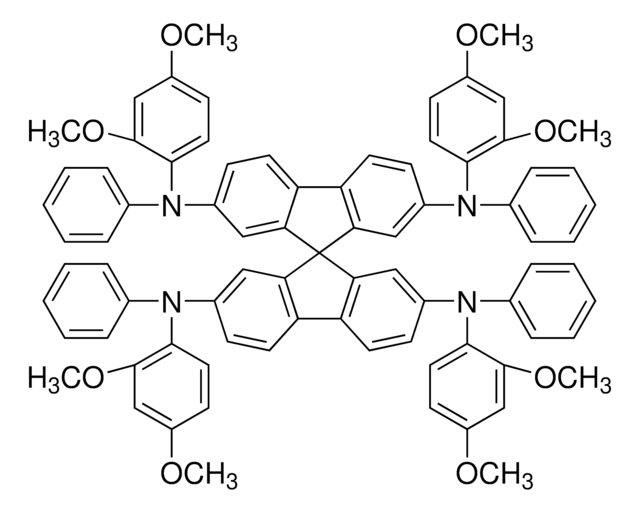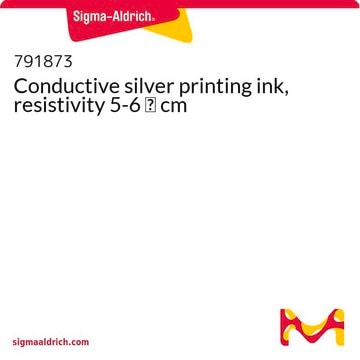791539
Titania paste, reflector
Synonyme(s) :
Greatcell Solar® WER2-O, TiO2 paste
About This Item
Produits recommandés
Description
Crystal Structure: > 99% anatase (analysis carried out on starting material, prior to paste manufacture)
Forme
paste (white)
Concentration
20.0 wt. % (+/- 1.2 wt%)
Taille moy. des particules
150-250 nm (scatter)
Viscosité
15000-25000 mPa.s (Analysis carried out with 20mm 4 degree cone/plate; 40 s-1)
InChI
1S/2O.Ti
Clé InChI
GWEVSGVZZGPLCZ-UHFFFAOYSA-N
Catégories apparentées
Description générale
Application
Scattering Titania Paste contains highly dispersed anatase scattering particles (150nm to 250nm). This paste produces a non-active scattering layer when applied onto a pre-printed active layer.
After drying; this paste must be fired – together with the pre-printed active layers – at or above 500°C. This results in an opaque sintered layer; with a thickness of ~3μm for one printed layer; when using a 90T mesh screen.
Storage: Store in the dark at 20°C
Informations légales
Greatcell Solar® is a registered trademark of Greatcell Solar
Mention d'avertissement
Warning
Mentions de danger
Conseils de prudence
Classification des risques
Eye Irrit. 2 - Skin Irrit. 2
Code de la classe de stockage
10 - Combustible liquids
Classe de danger pour l'eau (WGK)
WGK 1
Point d'éclair (°F)
195.8 °F
Point d'éclair (°C)
91 °C
Certificats d'analyse (COA)
Recherchez un Certificats d'analyse (COA) en saisissant le numéro de lot du produit. Les numéros de lot figurent sur l'étiquette du produit après les mots "Lot" ou "Batch".
Déjà en possession de ce produit ?
Retrouvez la documentation relative aux produits que vous avez récemment achetés dans la Bibliothèque de documents.
Les clients ont également consulté
Articles
Few Monolayer Atomic Layer Deposition (ALD) on Surfaces and Interfaces for Energy Applications
Dye-sensitized solar cells (DSCs) are 3rd generation solar cells combining the promise of high efficiency with low production costs.
Organic photovoltaics (OPVs) represent a low-cost, lightweight, and scalable alternative to conventional solar cells. While significant progress has been made in the development of conventional bulk heterojunction cells, new approaches are required to achieve the performance and stability necessary to enable commercially successful OPVs.
While dye sensitization as the basis for color photography has been accepted for a very long time,1 attempts to use this principle for the conversion of solar light to electricity generally had resulted only in very low photocurrents, below 100 nA/cm
Notre équipe de scientifiques dispose d'une expérience dans tous les secteurs de la recherche, notamment en sciences de la vie, science des matériaux, synthèse chimique, chromatographie, analyse et dans de nombreux autres domaines..
Contacter notre Service technique






![Dipyrazino[2,3-f:2′,3′-h]quinoxaline-2,3,6,7,10,11-hexacarbonitrile 95% (HPLC)](/deepweb/assets/sigmaaldrich/product/structures/151/558/c0e2c95f-5228-4864-a7a5-4b9765a19840/640/c0e2c95f-5228-4864-a7a5-4b9765a19840.png)


